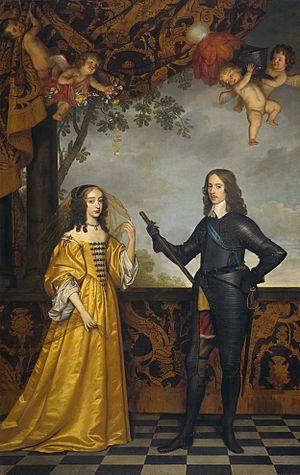Mary, Princess Royal and Princess of Orange facts for kids
Quick facts for kids Mary |
|||||
|---|---|---|---|---|---|
| Princess Royal | |||||
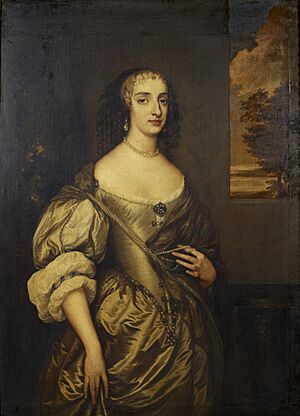
Portrait by Adriaen Hanneman, 1660
|
|||||
|
|||||
| Tenure | 14 March 1647 – 6 November 1650 | ||||
| Born | 4 November 1631 St James's Palace, City of Westminster, Middlesex, Kingdom of England |
||||
| Died | 24 December 1660 (aged 29) Whitehall Palace, City of Westminster, Middlesex, Kingdom of England |
||||
| Burial | 29 December 1660 Westminster Abbey, City of Westminster |
||||
| Spouse | |||||
| Issue | William III | ||||
|
|||||
| House | Stuart | ||||
| Father | Charles I of England | ||||
| Mother | Henrietta Maria of France | ||||
Mary, Princess Royal (Mary Henrietta Stuart; born November 4, 1631 – died December 24, 1660) was a British princess. She was part of the House of Stuart royal family. When she married, she became the Princess of Orange and Countess of Nassau. She also ruled for her young son from 1651 to 1660. Mary was the very first person to be called Princess Royal.
She was the oldest daughter of King Charles I and Queen Henrietta Maria. Mary married William II of Orange when she was only nine years old in 1641. He would later become a powerful leader in the Netherlands. At first, she stayed in England with her parents because of big political problems there. But in 1642, she and her mother moved to the Netherlands. In 1647, Mary's husband became the Prince of Orange and a leader (called a Stadtholder) in the United Provinces of the Netherlands.
Mary's husband died in 1650. Eight days later, she gave birth to their son, William III of Orange. He later became King of England, Scotland, and Ireland. Mary became the only guardian for her son. She was not very popular in the Netherlands because she supported her brothers. She also had a difficult relationship with her mother-in-law, Amalia of Solms-Braunfels. In 1660, the monarchy (royal rule) was brought back in England. Mary went to London to celebrate. Sadly, she got sick with smallpox and died there.
Contents
Mary's Early Life
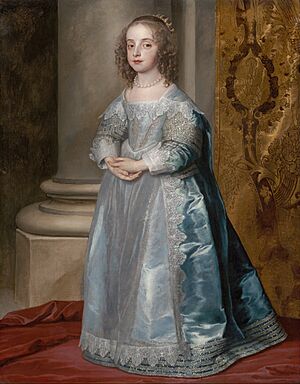
Princess Mary Henrietta was born on November 4, 1631. She was born at St James's Palace in London. She was the third child, but the second one to survive, and the oldest daughter of King Charles I and Queen Henrietta Maria. She was baptized on the same day she was born. This was because people worried she might not live. The ceremony was led by William Laud, the Archbishop of Canterbury. Mary was named after her grandmother, Marie de' Medici, who was Queen of France.
Mary spent her early years with her brothers and sisters. They lived at St James's Palace, Richmond Palace, and Hampton Court Palace. The Countess of Roxburghe was in charge of teaching the princesses. Mary was known for being graceful, beautiful, and having good manners. She was also very good at dancing. However, her knowledge of science was not as strong. Mary's mother, Queen Henrietta Maria, wanted her daughter to become Catholic. She even brought a young Catholic lady into Mary's friends. But King Charles I quickly stopped his wife's plans.

In January 1640, when Mary was 8 years old, she received her first marriage proposal. It was from 13-year-old William. He was the oldest son of Frederick Henry, Prince of Orange. William's mother, Amalia of Solms-Braunfels, had been a close friend of Mary's aunt, Elizabeth Stuart, Queen of Bohemia. This friendship later became important in Mary's life.
King Charles I first said no to the offer from the House of Orange. He wanted his daughter to marry Balthasar Charles, Prince of Asturias. Balthasar was the only son of King Philip IV of Spain and also Mary's cousin. For this marriage to happen, Mary would need to become Catholic. Mary had studied some Catholic teachings for her mother. But she did not want to change her faith. Also, her mother, Queen Henrietta Maria, did not like Spain and was against this marriage. Mary's cousin, Charles I Louis, Elector Palatine, also wanted to marry her. But this plan did not work out either.
Becoming Princess of Orange
By the late 1630s, there were many problems in England. People disagreed strongly about religion, society, and politics. Mary's mother, who was openly Catholic, became less and less popular. In late 1640 and early 1641, King Charles I decided to talk again with Prince Frederick Henry of Orange.
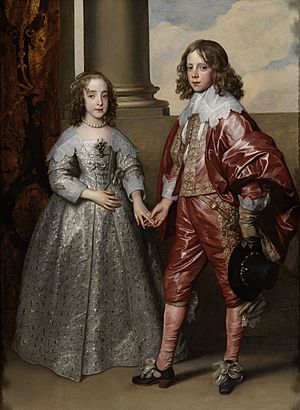
The talks went quickly. On February 10, 1641, King Charles told Parliament that his daughter's engagement was settled. He hoped that the Prince of Orange would help him keep his power in England if needed. A simple wedding ceremony happened on May 2, 1641. It took place at the Chapel Royal in Whitehall Palace in London. Queen Henrietta Maria could not attend the Protestant ceremony. She watched her daughter's wedding from a small balcony. The marriage was not celebrated much in England. The country was close to a war, which started less than a year later.
After the ceremony, William went back to the Netherlands. The marriage agreement said Mary could stay in England until she was 12. Her husband would give her money for her personal expenses. If William died early, Mary would receive yearly support and two homes. The agreement also allowed Mary and her English helpers to continue practicing the Church of England faith. They did not have to join the Dutch Reformed Church.
In early 1642, the situation in England became very tense. Mary and her parents had to go to Hampton Court for safety. But the problems quickly turned into a war. In February, Queen Henrietta Maria left with her daughter for The Hague in the Netherlands. They traveled on a Dutch fleet of fifteen ships. Mary was joined by her governess, Lady Stanhope. Lady Stanhope later became a close friend. Mary's marriage helped England in 1643. Queen Henrietta Maria convinced the Dutch government to give a ship and weapons to King Charles.
Just before leaving for the Netherlands, Mary's father gave her the title Princess Royal. This started the tradition that the oldest daughter of the British king or queen could have this title. The title was created because Queen Henrietta Maria, who was the daughter of King Henry IV of France, wanted her daughter to have a title like "Madame Royale". That was the title for the oldest daughter of the King of France. Before this, the oldest daughters of English and Scottish kings were just called lady or princess.
In November 1643, a second wedding ceremony took place in The Hague. Mary was 12, and William was 17. By February 1644, Mary was fully involved in the Dutch court. She met with people, including foreign ambassadors. She did all her duties with a seriousness and grace that surprised people for her age. In March, she took part in celebrations for a new alliance between France and the Netherlands. She also led the entertainment her husband planned for the French ambassador.
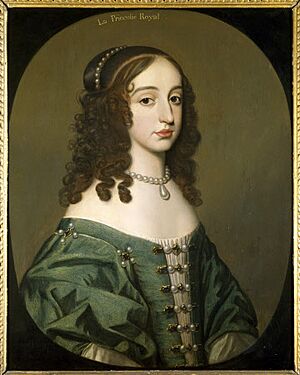
Mary kept getting news from England. She supported her father, King Charles. In December 1646, she sent him a letter. She urged him to escape to the Netherlands, but Charles said no. In The Hague, Mary became very close with her aunt, Elizabeth. Elizabeth was a former Queen of Bohemia who was living in exile. However, Mary did not get along well with her mother-in-law, Amalia. So she tried to spend as little time with her as possible.
Prince Frederick Henry of Orange died on March 14, 1647. On that day, William II became his father's heir. He was named Stadtholder and head of the army. Mary's husband then received all of his late father's other titles. In 1648, Mary's brothers, Charles, Prince of Wales, and James, Duke of York, visited her. In 1649, Mary's father, King Charles, was executed. After this, Mary helped many English Royalists who had to leave England. Among those she helped was the family of Anne Hyde. Anne later married the Duke of York and became the mother of two English Queens, Mary II and Anne.
Ruling for Her Son
In the autumn of 1647, Mary had a miscarriage. She could not get pregnant again for several years. In early 1650, she was pregnant once more. In late October or early November, her husband got sick with smallpox. He died on November 6, 1650. This was just after he tried to take over Amsterdam from his political rivals. Eight days after his death, on her nineteenth birthday, Mary gave birth to a son, William. The baby's crib was covered in black cloth to show mourning for his father. The titles of Stadtholder and Prince of Orange were not passed down automatically. So, the child did not receive them right after he was born.
Soon after her son's birth, Mary had arguments with her mother-in-law. Mary wanted to name her son Charles, after her executed father. But Amalia insisted the boy be named William. This was a better choice because the first ruler of the United Provinces of the Netherlands was William I of Orange. Also, the boy's late father had wanted to name his son William. Amalia won the argument over the name. She then wanted to become the boy's legal guardian. She said Mary was too young.
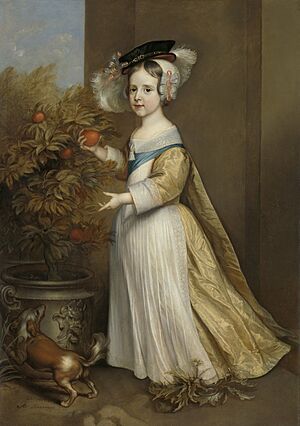
On August 13, 1651, the Supreme Court (Hoge Raad van Holland en Zeeland) decided that guardianship would be shared. It would be shared between Mary, her mother-in-law, and Frederick William, Elector of Brandenburg. The Elector was chosen because he could be a neutral person between the two women. He also had an interest in protecting the Orange family's money. Amalia worried Mary would spend it all.
Mary was generally not popular in the Netherlands. Many people there supported Oliver Cromwell in England. Mary refused to hire Dutch people to work for her son because of this. In January 1650, Mary, her brother James, and her aunt Elizabeth planned to quietly remember her father's death. But the Dutch government thought even small events would offend the English government. Later, when English Parliament envoys were welcomed by the States General, Mary went to her widow's home in Breda. But her supporters prevented the English from making an alliance with the Netherlands.
Mary secretly welcomed her brother Charles II in 1651. He believed he was the rightful King of England. After this, the Dutch government told her not to accept any more relatives. Mary's home was even called a "nest of vipers." People thought they were planning against the Netherlands, England, and Cromwell.
In 1652, feelings in the Netherlands changed. This was because of the war with England. Mary's son was officially chosen as stadtholder of Zealand and some northern provinces. But Johan de Witt, a republican leader, stopped William from being chosen in Holland. Also, when making a peace treaty, Cromwell insisted on the Act of Seclusion. This law stopped Holland from choosing a member of the Orange family as stadtholder. Cromwell also demanded that all enemies of the Commonwealth leave Holland. Mary officially protested, but her protest was ignored. The peace treaty was signed on May 27, 1654.
Mary's worries about her son's position affected her health. To save money for her brothers, she said she would give up two of her four palaces. In July 1654, she went to a water resort for a few weeks. Then she visited her brother Charles in Cologne, where his court was. She returned to the Netherlands in October. But in July 1655, she went to Charles in Cologne again. She visited a fair in Frankfurt secretly. She came home on November 15. In January 1656, Mary went to Paris. Her mother and younger sister Henrietta lived there. She was welcomed with great honor at the French court.
Later Life
In the Netherlands, Mary was a young widow. Many people admired her and wanted to marry her. One of them was George Villiers, 2nd Duke of Buckingham. People at the time said that Charles Emmanuel II, Duke of Savoy, Ernest Augustus, Duke of Brunswick-Lüneburg, and Ernest's brother George William also proposed to Mary in Paris. Cardinal Mazarin was especially kind to the princess. He also spread rumors that she was involved with Henry Jermyn. Jermyn was part of her brother James of York's household. The rumors were probably not true. But Charles II took them seriously. He tried to stop Jermyn and the princess from seeing each other.
Mary left Paris on November 21. After staying two months at her brother's court in Bruges, she returned to The Hague. Soon after she got back, Mary learned that her mother-in-law, Amalia, had offered her daughter Henriette Catherine to Charles II for marriage. This made Mary very angry. In 1658, Amalia tried to become the only ruler for her grandson. Mary was also appointed by the Supreme Court to rule for him. But Mary, with help from her French relatives, stopped her mother-in-law's plans.
In November 1659, Mary sent her son to study at Leiden University. On May 14, 1660, the Dutch parliament told Mary, who was in Breda, that the monarchy was back in England. Her brother Charles (now King Charles II) was on the throne. A few days later, she took part in celebrations in The Hague. Mary was now third in line to the English throne. This was after her brothers, James and Henry. (Henry would die later that same year). Her new status as an English princess helped people in the Netherlands like her more. In all the cities Mary and her son visited, they were welcomed with royal honors. After the monarchy was restored, the Act of Seclusion was canceled. In 1660, Mary and her mother-in-law worked together. They tried to get several provinces to accept William as the future Stadtholder. But many refused at first.
On September 30, 1660, Mary sailed to England. She was known for caring about her exiled friends and brothers. So, she was warmly welcomed. When she arrived in London, Mary was surprised and upset. Her brother the King had recognized the marriage of James, Duke of York, to Anne Hyde. Anne was Mary's former lady-in-waiting. The King also said their children would be English princes and princesses with full rights to the throne. This upset Mary so much that she decided to shorten her visit. She attended a service at Whitehall Chapel. Many people came to see her. She also held a private reception at Whitehall for Elias Ashmole. She accepted a gift of money from Parliament. She also asked for a dowry (money given to a bride) that had been promised long ago. The King appointed a group to solve this issue. In November 1660, Mary met with the Dutch Embassy. They came to renew an alliance with England.
Death
On December 20, the English court heard that Mary was very sick with smallpox. When Queen Henrietta Maria heard this, she came to her dying daughter's side. She tried one last time to convince Mary to become Catholic, but Mary refused. The Queen managed to insist that her French doctor treat the princess. Many people at the time believed this was fatal for Mary. The doctor was a strong believer in bloodletting. On December 24, Mary signed her will and died on the same day. As she wished, she was buried in Westminster Abbey. She was buried next to her brother Henry, Duke of Gloucester. He had also died of smallpox in September 1660.
In her will, Mary asked the King to look after her 10-year-old son. His grandmother Amalia was now his only guardian. In 1672, after fighting with republican leaders in the Netherlands, 21-year-old William was chosen as stadtholder of five provinces. This started with Holland on July 4. He was also named commander-in-chief. Five years later, he married his cousin Mary. She was the daughter of James II and Anne Hyde. In 1688, with the help of English Protestants, William removed Mary's father from the throne. He and his wife were then declared co-rulers of England, Scotland, and Ireland.
Ancestry
| Ancestors of Mary, Princess Royal and Princess of Orange | |||||||||||||||||||||||||||||||||||||||||||||||||||||||||||||||||||||||||||||||||||||||||||||||||||||||||||||||||||||||||||||||||||||||||||||||||||||||||||||||||||||||||||||||||||||||||||||||||||||||||||||||||||||||||||||||||||||||||||||||||||||||||||||||||||||||||||||||||||||||||
|---|---|---|---|---|---|---|---|---|---|---|---|---|---|---|---|---|---|---|---|---|---|---|---|---|---|---|---|---|---|---|---|---|---|---|---|---|---|---|---|---|---|---|---|---|---|---|---|---|---|---|---|---|---|---|---|---|---|---|---|---|---|---|---|---|---|---|---|---|---|---|---|---|---|---|---|---|---|---|---|---|---|---|---|---|---|---|---|---|---|---|---|---|---|---|---|---|---|---|---|---|---|---|---|---|---|---|---|---|---|---|---|---|---|---|---|---|---|---|---|---|---|---|---|---|---|---|---|---|---|---|---|---|---|---|---|---|---|---|---|---|---|---|---|---|---|---|---|---|---|---|---|---|---|---|---|---|---|---|---|---|---|---|---|---|---|---|---|---|---|---|---|---|---|---|---|---|---|---|---|---|---|---|---|---|---|---|---|---|---|---|---|---|---|---|---|---|---|---|---|---|---|---|---|---|---|---|---|---|---|---|---|---|---|---|---|---|---|---|---|---|---|---|---|---|---|---|---|---|---|---|---|---|---|---|---|---|---|---|---|---|---|---|---|---|---|---|---|---|---|---|---|---|---|---|---|---|---|---|---|---|---|---|---|---|---|---|---|---|---|---|---|---|---|---|---|---|---|---|---|---|---|
|
|||||||||||||||||||||||||||||||||||||||||||||||||||||||||||||||||||||||||||||||||||||||||||||||||||||||||||||||||||||||||||||||||||||||||||||||||||||||||||||||||||||||||||||||||||||||||||||||||||||||||||||||||||||||||||||||||||||||||||||||||||||||||||||||||||||||||||||||||||||||||
See also
 In Spanish: María Enriqueta Estuardo para niños
In Spanish: María Enriqueta Estuardo para niños


